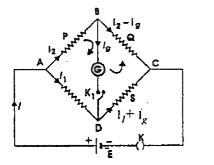Using Kirchoff's law, derive the condition for the balance of a Wheatstone bridge circuit.Solution in Punjabi
Wheatstone bridge : Wheatstone bridge consists of four resistances P, Q, R and S arranged so as to form a quadrilateral ABCD as shown in fig. A cell E and a key K are connected between points A and C. A galvanometer G and a tapping key K1 are connected between points B and D. On closing the key K first and then key K1, if galvanometer shows no deflection, then bridge is said to be balanced. In that case, Ig=0 and

PQ=RS
Knowing P, Q and R, we can calculate unknown resistance S.
Proof Let E= emf of the cell
I = Total current given by the cell.
At junction A, current I is divided into two parts, I1 (flowing through arm (AD) and I2 (flowing through arm AB). At junction B, current I2 is again divided into two parts Ig (through BD) and I2−Ig (through BC). At D, current I1andIg combine and hence current flowing through DC is I1+Ig. At C, current (I2−Ig)and(I1+Ig) combine and I1+I2=I flows out and completes the circuit. Using Kirchhoff.s Second law in closed mesh ABDA.
I2P+IgG−I1R=0 ...(I)
where G= Resistance of galvanometer
Using Kirchhoff.s second law in closed circuit BDCB, IgG+(I1+Ig)S−(I2−Ig)Q=0 ...(II)
When bridge is balanced, i.e., when no current flows through the galvanometer (this can be done by adjusting the value of resistance R), then Ig=0
Putting Ig=0, in eqns (I) and (II) we get
I2P+0−I1R=0
or I2P=I10R ...(III)
and 0+(I1+0)S−(I2−0)Q=0
I2S−I2Q=0
i2Q=I1S ...(IV)
Dividing (III) by (IV),
I2PI2Q=I1RI1S
⇒PQ=RS
Hence the proof.
Topper's Solved these Questions
- ELECTRICAL MEASUREMENTSBook:BETTER CHOICE PUBLICATIONChapter:ELECTRICAL MEASUREMENTSExercise:Long Answer Type Questions
Explore 7 Videos
- ELECTRICAL MEASUREMENTSBook:BETTER CHOICE PUBLICATIONChapter:ELECTRICAL MEASUREMENTSExercise:Numericals Problems
Explore 9 Videos
- ELECTRICAL MEASUREMENTSBook:BETTER CHOICE PUBLICATIONChapter:ELECTRICAL MEASUREMENTSExercise:Most Expected Questions
Explore 7 Videos
- ELECTRICAL DEVICESBook:BETTER CHOICE PUBLICATIONChapter:ELECTRICAL DEVICESExercise:(MOST EXPECTED QUESTIONS 2 MARK)
Explore 2 Videos
- ELECTROMAGNETIC INDUCTIONBook:BETTER CHOICE PUBLICATIONChapter:ELECTROMAGNETIC INDUCTIONExercise:NUMERICAL PROBLEMS
Explore 26 Videos
Similar Questions
State and explain Kirchhoff's laws.
View SolutionA cell of e.m.f. 1 V gives a balance point at 40 cm length of a potentioeter wire. For another cell, the balance point shifts to 60 cm. Find the e.m.f. of the second cell.
View SolutionWhy is a slide wire bridge also called a metre bridge?
View SolutionWhy the core of a transformer made of a magnetic material of high permeability?
View SolutionA magnetic field of 2×10−2T acts at right angles to a coil of area 100cm2 with 50 turns. The average e.m.f. induced in the coil is 0.1 V, When it is removed form the field in the time t. The value of t is
View Solution(a) Derive the conduction of balance for wheatstone bridge. (b) Draw the circuit diagram of a meter bridge to explain how it is based on wheatstone bridge.
View SolutionState Kirchhoff's law for an electrical network. Using these laws deduce the conditions for balance in a wheatstone bridge.
View SolutionDraw the circuit digram of a Wheatstone bridge and write down its balance condition .
View SolutionUse Kirchhoff s rules to obtain conditions for the balance condition in a Wheatstone bridge.
View SolutionDraw the circuit diagram of a Wheatstone bridge. Derive the balancing condition for the same. Name a device which works on the principle of Wheatstone bridge.
View SolutionWhat is the condition for balance of a Wheatstone bridge?
View SolutionUsing Kirchoff's law, derive the condition for the balance of a Wheatstone bridge circuit.
View SolutionDraw diagram of aWheatstone bridge and by using Kirchhoff’s Laws derive the condition for balance of Wheatstone bridge.
View SolutionDerive the condition of balance for Wheatstone bridge.
View SolutionApply Kirchoff's laws of current electricity to establish the condition of a balanced Wheatstone's bridge.
View Solution
